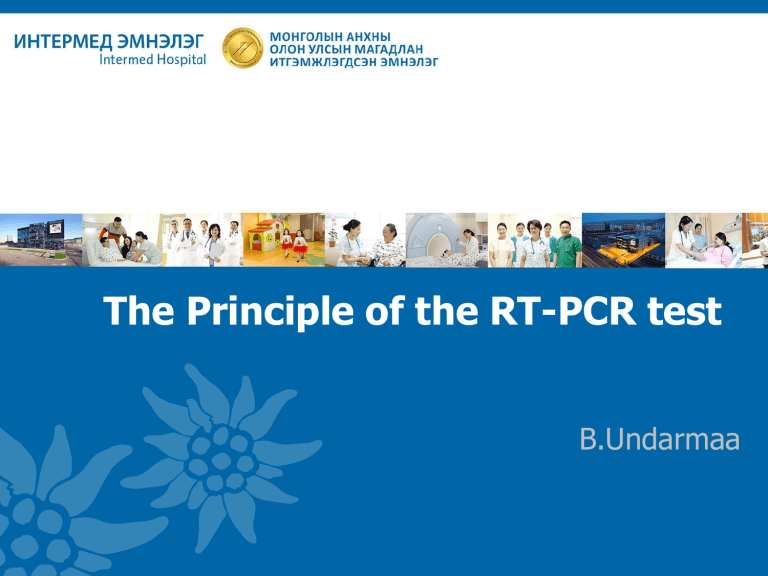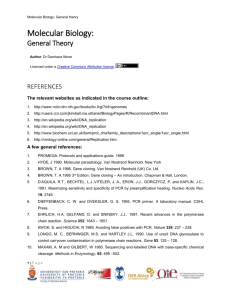
The Principle of the RT-PCR test B.Undarmaa OUTLINE I. Brief introduction to Molecular Biology section II. Molecular Biology equipment III. Basics of Molecular Biology IV. What is PCR ? V. Briefly about nucleic acid extraction VI. RT-PCR in brief VII.Cautions 1. Brief introduction to Molecular Biology section I. Brief introduction to Molecular Biology section • RT-PCR • STD 7 pathogens • Vaginitis screening assay- 7 • Clinical pathologist-1 • Biomedical scientists-4 • Laboratory technicians- 3 In total 3 methods are used in 14 different lab orders. • • • RT-PCR SARS-CoV-2 assay Respiratory 8 types of viruses • Rt-PCR • Monkeypox assay • H.pylori/Clari/R assay • Nested-PCR /Filmarray/-onestep • Respiratory panel with/ without SARS-CoV-2 • Meningitis/Encephalitis panel • Rt-PCR melting point analysis-onestep/ GeneXpert • HBV DNA, HCV-RNA, MTB/RIF assay • Rt-PCR melting point analysis • HPV-14 High risk types 2. Molecular Biology equipment HBV HCV MTB: 45-105 minutes Molecular Laboratory section The old equipment: 3. Basics of Molecular Biology Basics of Molecular Biology Genetic information contained in DNA DNA is built in a double helix DNA encodes the genetic information (different genes, different information) DNA is organized into a long chain called chromosomes 23 pairs of chromosomes are in the nucleus of human cells © Cepheid Basics of Molecular Biology DNA building blocks DNA is made up of 4 nucleotides – A = Adenine – T = Thymine G A T – C = Cytosine – G = Guanine The 4 bases are linked together to form a sequence (single strand of DNA) G C T T A T G C A T 7 © Cepheid C Basics of Molecular Biology Basic Molecular Biology Most DNA is double stranded and pairs in a unique way: G C Sugar Phosphate 3’ Linkages give a DNA strand a Direction Strands of a duplex are anti parallel 8 © Cepheid 5’ T A 5’ C G A A T A C G T A G C T T A T G C A T 3’ 4.What is PCR ? What is PCR ? 1. The tool usedPCR (Polymerase Chain Reaction) is a chain (cyclic) reaction which generates copies of a specific sequence of DNA present in the sample. 2. To replicate DNA is the enzyme polymerase. RNA can also be a starting product. /cDNA/ 3. Primer-short set of DNA that is specific to certain gene © Cepheid RdRp/S gene The extraction was manual: 5. Briefly about nucleic acid extraction What is happening with the Real-Time PCR instrument? Real-time PCR instruments consist of THREE main components: 1. Thermal Cycler (PCR machine) 2. Optical Module (to detect fluorescence in the tubes during the run) 3. Computer (to translate the fluorescence data into meaningful results) • Manufacturer: Korea Introduction • Extraction limit/time 32- 23 minutes • Compatible automated system: SeePrep 32 • Quality certificates • Principle: Magnetic beads Intended use: • • • • • • • • Naso-pharyngeal swab Oro-pharyngeal swab Urine Feces Rectal swab Sputum Uro-genital swab/vaginal, cervical, urethral/ Liquid based cytology • Lysis buffer- to lyse the cell/detergent and proteinase K/ • Binding buffer- Will be added to the lysate a suitable condition will form for the nucleic acids to bind with the magnetic beads. • WB1, WB2- /isopropanol and ethanol to remove cell debris/ • WB3 – Water based! To remove the residual ethanol from previous step /also contains magnetic beads/ • Elution buffer- DNA is eluted in a low-salt buffer to allow for pH stabilization of the DNA in storage. /DNA is water soluble/ 6. RT-PCR in brief What is Real-Time PCR? The Polymerase Chain Reaction (PCR) is a process for the amplification of specific fragments of DNA. Real-Time PCR a specialized technique that allows a PCR reaction to be visualized “in real time” as the reaction progresses. As we will see, Real-Time PCR allows us to measure minute amounts of DNA sequences in a sample! What is happening with the Real-Time PCR instrument? Real-time PCR instruments consist of THREE main components: 1. Thermal Cycler (PCR machine) 2. Optical Module (to detect fluorescence in the tubes during the run) 3. Computer (to translate the fluorescence data into meaningful results) What is Real-Time PCR used for? Real-Time PCR has become a cornerstone of molecular biology: • Gene expression analysis – Cancer research – Drug research • Disease diagnosis and management – Viral quantification • Food testing – Percent GMO food • Animal and plant breeding – Gene copy number • Forensic science - Paternal determination Master mix components Components of a PCR reaction GCTTATGCAT • DNA template (virus, bacterial or human genome) • Primers (oligonucleotides of about 21 nucleotides, which will anneal to the target DNA) • Polymerase (a natural enzyme that can replicate DNA once primers have annealed, eg: Taq polymerase) • dNTP’s (a mix of all four nucleotides required to build DNA: A, T, C, G) • Buffer (Mg2+, Tris-HCl, Triton: providing the optimal conditions for the polymerase to work) • Probe (fluorophore and quencher: if seperates from eachother, the fluorophore will emit light) © Cepheid T G A C Taq polymerase RT-PCR Taqman Probe GCTTATGCAT T G A C Taq polymerase PCR steps DNA or RNA PCR STEPS: first phase of a PCR cycle - Denaturation denaturation separation of DNA strands • 90-95 ºC • 20-30 sec. PCR STEPS: second phase of a PCR cycle Annealing annealing specific primer binding Temperature: 40-65 ºC Duration: 20-40 seconds 5 © Cepheid PCR STEPS: 3rd phase of PCR cycle- extension GCTTATGCAT extension 5’. Reverse primer 3’ Pol 3’ 5’ Forward primer • 60-75 ºC Duration depends on the sequence size to be amplified © Cepheid Баднаа 5000000 4500000 4 units Ct=23 Доржоо 4000000 3500000 3000000 2500000 2000000 1 unit Ct=25 Аюуш 1500000 1000000 500000 0 0 1/8 unit Ct=28 5 10 15 20 25 30 35 40 Let’s imagine that you start with four times as much DNA as I do…picture our two tubes at cycle 25 and work backwards a few cycles. Imagining Real-Time PCR Cycle 25 Measuring Quantities Cycle Me You 23 250,000 1,000,000 24 500,000 2,000,000 25 1,000,000 4,000,000 LOD: H.pylori- >50 copies/reaction ClariR- >100 copies reaction • Respiratory 8 types of viruses • STD-7 • Vaginitis screening-7 • HPV-14 Polymerase Chain Reaction Evolution • Monkeypox Homebrew PCR • COVID-19 PCR Batch Xpert Tests Patient Sample(s) Patient Sample(s) Washing Sample Preparation Nucleic acid extraction Purification • HCV/HBV/MTB/RIF NAAT MasterMix Amplification and Detection Result Interpretation by Lab Technician 3 4 • Respiratory panel 17 • Respiratory panel with SARS-CoV-2 • Meningitis/Encephalitis panel-14 Automatic Result Interpretation Flexi Batch 7. Cautions Cautions ⚠ • Working area and the benchtop should be clean • Work with clean gloves • Pre-PCR and Post PCR items should not be mixed • All plastic wears should be RNAse and DNAse free THANK YOU SO MUCH


